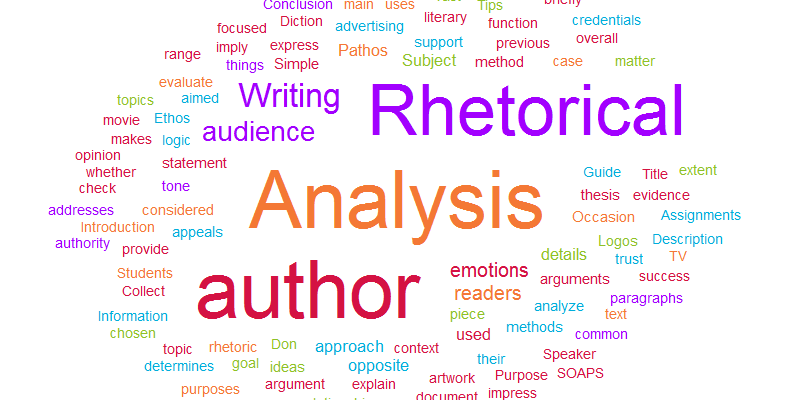Writing a Rhetorical Analysis

Assignments of this kind imply a vast range of topics. You may write an analysis of a book, a movie, an artwork, an advertising, or a TV show. No matter what it is, your goal is to analyze any kind of statement intended for a certain audience. You have to explain how the author makes his or her arguments, and express your opinion on whether this argument was successful or not. If you want to learn more about a rhetorical analysis, check our simple guide.
Collect Information
First of all, you have to identify such important things as Subject, Occasion, Audience, Purpose, and Speaker (SOAPS). The subject is a topic that the author addresses, The occasion means the overall context. It to a large extent determines the chosen tone. The speaker is the author. If he or she has some credentials that point to their authority on the considered subject, you must briefly describe it. Any piece of writing or artwork may have different purposes. The purpose is most important when analyzing an advertising. The audience is who the considered piece was written for. Sometimes, the occasion may give you a hint on who is the audience.
Now, you have to analyze the appeals. Let’s take a closer look at them.
- Logos. Logos is aimed at the readers’ logic. It’s the most reasonable and informative approach, and it involves the use of facts, data, and evidence. This approach is most common in academic discussions.
- Pathos. This method is somewhat opposite to the previous one, as it targets emotions of the audience. The author may try to make readers feel sympathy, love, anger, or other emotions in order to support his or her point. If you read an article about victims of some crime that provides many details about their lives and relationships, it means that the author used pathos.
- Ethos. Unlike previous approaches, this one doesn’t target logic nor emotions. It’s aimed at social relationships and trust. In this case, the author wants you to agree with them just because they have a good experience in this field, or because other people trust them. Despite the name, this approach has nothing to do with ethics in its traditional meaning.
After this, note all useful details about the author’s style. There are several common stylistic methods that serve the rhetoric function, and here is an incomplete list of them:
- Repetition of a certain idea to make it more memorable.
- A tone sets the mood. The tone of a book or other literary work may be formal or informal, sarcastic, scientific, etc.
- Analogies are means of a figurative language. This method compares two objects, events, or ideas.
- Diction is all about a word choice. Some words express strong emotions and so increase an impact of a literary piece. Diction also implies a certain rhythmical pattern that performs the same function.
- Addressing the opposite point is a good approach that demonstrates that the author is confident enough in some idea so he or she is not afraid of mentioning the opposite idea. It also allows the writer to refute the opposite point.
- Imagery is related to pathos appeals. The author uses vivid images to make readers feel certain emotions.
Write an Introduction
First of all, you need to explain your audience what your paper is about. Let them know what to expect, acquaint them with a simple definition of rhetoric and rhetorical methods that you’re going to analyze. Introduce a text or any other document that will be a subject of your analysis. You can provide a brief summary of the document, but make sure you save all the details for later so that you’ll have enough ideas for your body paragraphs. After this, come up with your thesis statement. It may be about some rhetorical technique that the author used successfully. The main thing is to provide an original argument about the considered work.
Write a Body
We suggest organizing body paragraphs by rhetoric appeals. Tell your readers when and how the author uses pathos, logos, and ethos, and support each paragraph with examples.
Another way to organize your analysis is to write everything in chronological order. Consider all rhetorical details as they appear in the text. In this case, you will follow the same structure as used by the author so this method may help you create more coherent analysis.
Don’t forget to support your own thoughts with evidence. You may use direct quotes or paraphrases.
Write a Conclusion
Restate your thesis statement and key ideas. Don’t repeat your thesis word-for-word like you did in the introduction. Rephrase it using new terms in the context of your main arguments.
End your conclusion highlighting things that your readers would never learn if they didn’t read your rhetorical analysis.